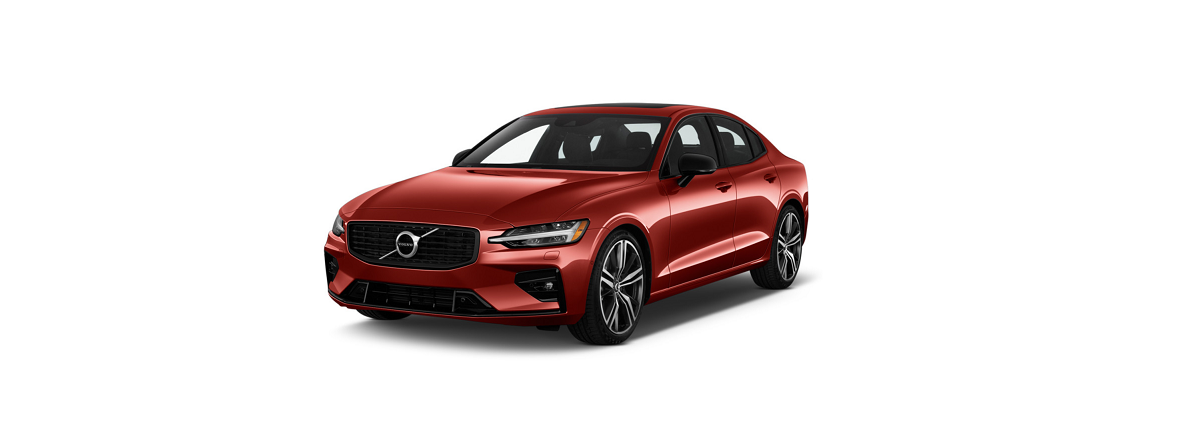2022 Volvo S60 City Safety

City Safety™
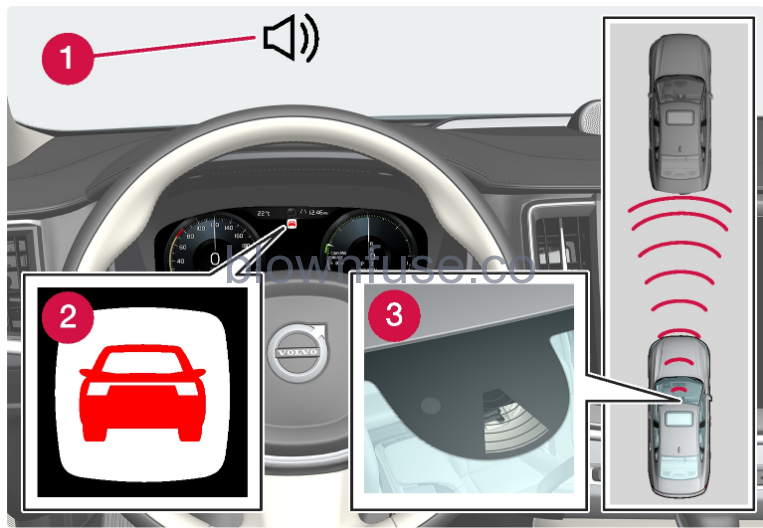 Function overview
Function overview- Acoustic signal in the event of a risk of collision
- Warning signal in the event of a risk of collision
- Distance measurement with the camera and radar unit
- The function can help the driver avoid a collision when, for example, driving in heavy traffic, where changes in the traffic ahead coupled with inattentiveness can lead to an incident. City Safety then activates brief, heavy braking and the car normally stops just behind the vehicle in front.
- The function helps the driver by automatically braking the car in the event of an imminent risk of collision if the driver does not react in time by braking and/or swerving.
- City Safety is activated in situations where the driver should have started braking earlier, which is why it cannot help the driver in every situation. The function is designed to be activated as late as possible in order to avoid unnecessary intervention. Automatic braking takes place only after or at the same time as the collision warning.
- The driver or passengers are not normally aware of City Safety – it only intervenes in a situation where a collision is immediately imminent.
- The function is supplementary driver support intended to facilitate driving and make it safer – it cannot handle all situations in all traffic, weather, and road conditions.
- The driver is advised to read all sections in the Owner’s Manual that relate to this function to learn about factors such as its limitations and what the driver should be aware of before using the system.
- Driver support functions are not a substitute for the driver’s attention and judgment. The driver is always responsible for ensuring the car is driven in a safe manner, at the appropriate speed, at an appropriate distance from other vehicles, and in accordance with current traffic rules and regulations.
Subfunctions for City Safety
Ability to reduce speed
If the speed difference between the driver’s car and the obstacle is greater than the following specified speeds, the City Safety auto-brake function cannot prevent a collision but it can mitigate the consequences of a collision.
Vehicles
For a vehicle in front, City Safety can reduce the speed by up to 60 km/h (37 mph).
Cyclists
For a cyclist, City Safety can reduce the speed by up to 50 km/h (30 mph).
Pedestrians
For a pedestrian, City Safety can reduce speed by up to 45 km/h (28 mph).
Large animals
In the event of a risk of a collision with a large animal, City Safety can reduce the car’s speed by up to 15 km/h (9 mph). The brake function for large animals is primarily intended to reduce the force of the impact at higher speeds and is most effective at speeds above 70 km/h (43 mph) but less effective at lower speeds.
The steps of City Safety
City Safety carries out three steps in the following order:
- Collision warning
- Brake support
- Auto Brake
1 – Collision Warning
The driver is first warned of a potentially imminent collision. In cars equipped with a head-up display, the warning is shown on the windscreen by a flashing symbol.
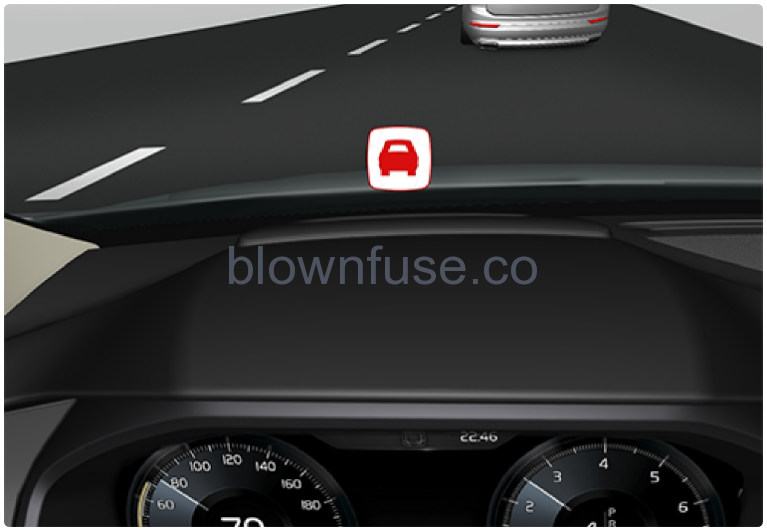 The symbol for collision warning on the windscreen
The symbol for collision warning on the windscreenStrong sunlight, reflections, extreme light contrasts, the use of sunglasses, or if the driver is not looking straight ahead may make the visual warning signal in the windscreen difficult to recognize. City Safety can detect pedestrians, cyclists, or vehicles that are stationary or moving in the same direction as the car and are ahead. City Safety can also detect pedestrians, cyclists, or large animals that are crossing the road in front of the car. In the event of a risk of collision with a pedestrian, larger animal, cyclist, or vehicle, the driver is alerted by means of a visual, acoustic, and brake pulse warning. There is no brake pulse warning at lower speeds, sudden driver braking, or acceleration. The brake pulse frequency varies according to the car’s speed.
2 – Brake support
If the risk of collision has increased further after the collision warning then the brake support is activated. Brake support reinforces the driver’s braking action if the system considers that the braking is not sufficient to avoid a collision.
3 – Auto Brake
The automatic brake function is activated last. If in this situation the driver has not yet started to take evasive action and the risk of collision is imminent then the automatic braking function is deployed – this takes place irrespective of whether or not the driver brakes. Braking then takes place with full brake force in order to reduce collision speed, or with limited brake force if it is sufficient to avoid a collision. The seatbelt tensioner can be activated in connection with the engagement of the automatic brake function. In some situations, the action of Auto-brake may begin with light braking and then progress to full brake action. When City Safety has prevented a collision with a stationary object, the car remains stationary in anticipation of positive action by the driver. If the car has been braked to avoid collision with a slower vehicle in front, its speed is reduced to match that of the vehicle in front.
Note
In cars with a manual gearbox, the engine stops when the Auto-brake function has stopped the car unless the driver has managed to depress the clutch pedal beforehand. The driver can always interrupt a braking intervention by firmly depressing the accelerator pedal.
Note
When City Safety brakes, the brake lights come on. When City Safety is activated and brakes the vehicle, the driver display shows a text message to the effect that the function is/has been active.
Warning
City Safety must not be used by the driver to change his/her driving style – the driver must not rely on City Safety alone and allow it to do the braking.
Setting the warning distance for City Safety
- The City Safety function cannot be deactivated. It is activated automatically when the engine/electric operation is started and remains switched on until the engine/electric operation is switched off.
- The warning distance determines the sensitivity of the system and regulates the distance at which a visual, acoustic, and brake pulse warning should be deployed.
- To select warning distance:
- Select settings in the center display’s top view.
- Under City Safety Warning, select either Late, Normal, or Early to set the desired warning distance.
- If the Early setting produces too many warnings, which could be perceived as irritating in certain situations, the Normal or Late warning distance can be selected.
- When warnings are perceived as being too frequent or disturbing, the warning distance can be reduced, which reduces the total number of warnings and instead leads to City Safety giving a warning at a later stage.
- The Late warning distance should therefore only be used in exceptional cases, such as in dynamic driving.
Warning
- No automatic system can guarantee 100% correct function in all situations. Therefore, never test City Safety by driving at people, animals, or vehicles – this may cause severe damage and injury and risk lives.
- City Safety warns the driver when there is a risk of a collision, but it cannot shorten the driver’s reaction time.
- Even if the warning distance has been set to Early warnings could be perceived as being late in certain situations, e.g. when there are large differences in speed or if vehicles ahead suddenly brake heavily.
- With the warning distance set at Early, the warnings will come more in advance. This may mean that the warnings come more frequently than at the warning distance Normal, but it is recommended since it can make City Safety more effective.
Messages for City Safety
| Message | Specification |
|---|---|
| City Safety
Automatic intervention |
When City Safety brakes or has done an automatic braking, several of the driver display symbols may be illuminated in connection with a text message being shown. |
| City Safety
Reduced functionality Service required |
The system does not function as it should. A workshop should be contacted. |
A text message can be cleared by briefly pressing the button, located in the center of the steering wheel’s right-hand keypad. If a message persists, contact a workshop.
Limitations of City Safety
Surroundings
Low objects
Low-hanging objects, e.g. a flag/pennant for projecting load, or accessories such as auxiliary lamps and bull bars that are higher than the bonnet, will limit the function.
Skidding
On slippery road surfaces, the braking distance is extended, which may reduce the capacity of City Safety to avoid a collision. In such situations, the anti-lock brakes and the stability control ESC are designed to give the best possible braking force with maintained stability.
Oncoming light
The visual warning signal in the windscreen may be difficult to notice in the event of strong sunlight, reflections, when sunglasses are being worn or if the driver is not looking straight ahead.
Heat
In the event of high passenger compartment temperature, caused by e.g. strong sunlight, the visual warning signal in the windscreen may be temporarily disengaged.
The camera and radar unit’s field of view
The camera’s field of vision is limited, which is why pedestrians, large animals, cyclists, and vehicles in some situations cannot be detected, or they are detected later than anticipated.
Dirty vehicles may be detected later than others and if it is dark, motorcycles may be detected late or not at all.
If a text message in the driver display indicates that the camera or radar unit is obstructed, City Safety may be unable to detect pedestrians, large animals, cyclists, vehicles, or road lines ahead of the car. This means that the functionality of City Safety may be reduced.
However, an error message is not shown in all situations where the windscreen sensors are obstructed. The driver must therefore take care to keep the area of the windscreen in front of the camera and radar unit clear.
Important
Maintenance of driver support components must only be performed at a workshop – an authorized Volvo workshop is recommended.
Driver intervention
Reversing
When your own car is reversing, City Safety is temporarily deactivated.
Low speed
City Safety is not activated at very low speeds – below 4 km/h (3 mph) – and the system, therefore, does not intervene in situations where your car is approaching a vehicle ahead very slowly, e.g. when parking.
Active driver
Driver commands are always prioritized, which is why City Safety does not intervene or postpone warning/intervention in situations where the driver is steering and accelerating in a decisive manner, even if a collision is unavoidable. Active and aware driving behavior can therefore delay a collision warning and intervention in order to minimize unnecessary warnings.
Important warnings
The driver supports only warn of obstacles that their radar unit has detected – hence a warning may not be given, or it may be given with a certain delay.
- Never wait for a warning or intervention. Apply the brakes when the situation requires.
Warning
- Warnings and brake interventions could be implemented late or not at all if a traffic situation or external influences mean that the camera and radar unit cannot detect pedestrians, cyclists, large animals or vehicles correctly.
- For vehicles to be detected at night, their headlamps and rear lamp cluster must be switched on and shining clearly.
- The camera and radar unit have a limited range for pedestrians and cyclists. The system can provide effective warnings and brake interventions as long as the relative speed is below 50 km/h (30 mph). For stationary or slow-moving vehicles, warnings and brake interventions are effective at vehicle speeds up to 70 km/h (43 mph). The speed reduction for large animals is less than 15 km/h (9 mph) and can be achieved at vehicle speeds above 70 km/h (43 mph). The warning and brake intervention for large animals is less effective at lower speeds.
- Warnings for stationary or slow-moving vehicles as well as large animals may be disengaged due to darkness or poor visibility.
- Warnings and brake interventions for pedestrians and cyclists are deactivated at vehicle speeds exceeding 80 km/h (50 mph).
- Do not place, stick, or mount anything on the outside or inside of the windscreen in front of or around the camera and radar unit — this can interfere with camera-dependent functions.
- Objects, snow, ice, or dirt in the area of the camera sensor may reduce its functionality, fully deactivate it or give an incorrect function response.
Warning
- The City Safety auto-brake function can prevent a collision or reduce collision speed, but to ensure full brake performance the driver should always depress the brake pedal – even when the car auto-brakes.
- The warning and steering assistance are only activated if there is a high risk of collision – you must therefore never wait for a collision warning or for City Safety to intervene.
- The warning and brake intervention for pedestrians and cyclists are deactivated at vehicle speeds exceeding 80 km/h (50 mph).
- City Safety does not activate any auto-brake functions in the event of heavy acceleration.
Note
This function uses the car’s camera and radar units, which have certain general limitations.
Market limitation
City Safety is not available in all countries. If City Safety does not appear in the center display’s Settings menu, the car is not equipped with this function. Search path in the top view of the center display:
City Safety brakes for oncoming vehicles
If an oncoming vehicle enters your car’s lane and a collision is unavoidable, City Safety can reduce the car’s speed with a view to reducing the violence of the impact.
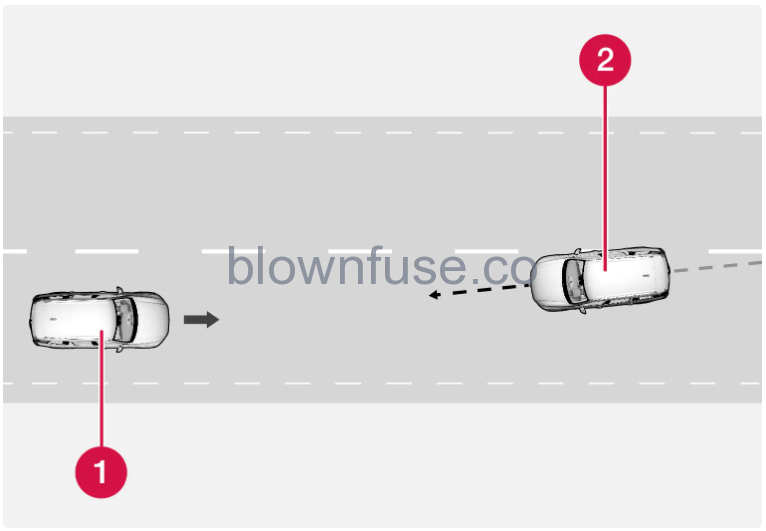
| 1 | Your car |
| 2 | Oncoming vehicles |
For this function to work, the following criteria must be met:
- your car must be traveling at more than 4 km/h (3 mph)
- the road section must be straight
- your car’s lane must have clear lane markings
- your car must be positioned straight in its own lane
- the oncoming vehicle must be within your car’s lane markings
- the oncoming vehicle must have its headlamps switched on
- this function can only handle “front to front” collisions
- this function can only detect vehicles with four wheels.
Warnings and brake interventions due to an impending collision with an oncoming vehicle always come very late.
City Safety in cross traffic
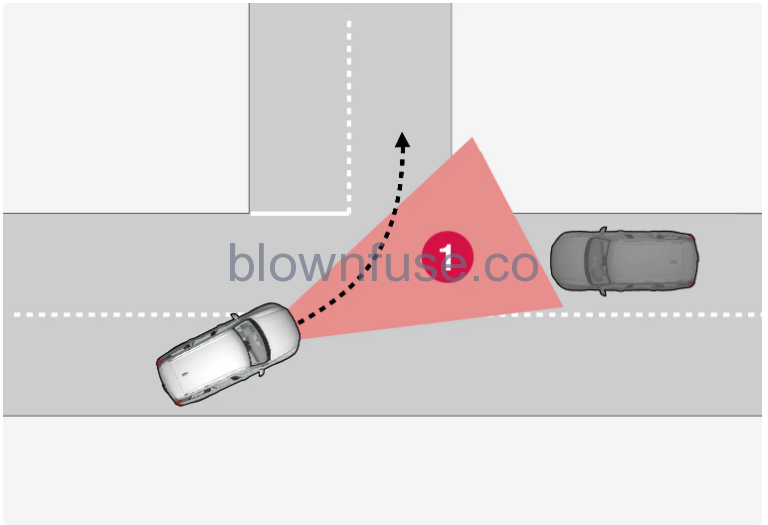
- Sector in which City Safety can detect oncoming crossing vehicles.
For City Safety to detect an oncoming vehicle on a collision course, the oncoming vehicle must first enter the sector in which City Safety can analyze the situation.
In addition:
- your car’s speed must be at least 4 km/h (3 mph).
- your car must turn to the left in markets with right-hand traffic (or to the right in left-hand traffic).
- the oncoming vehicle must have its headlamps switched on.
Limitations for City Safety in cross traffic
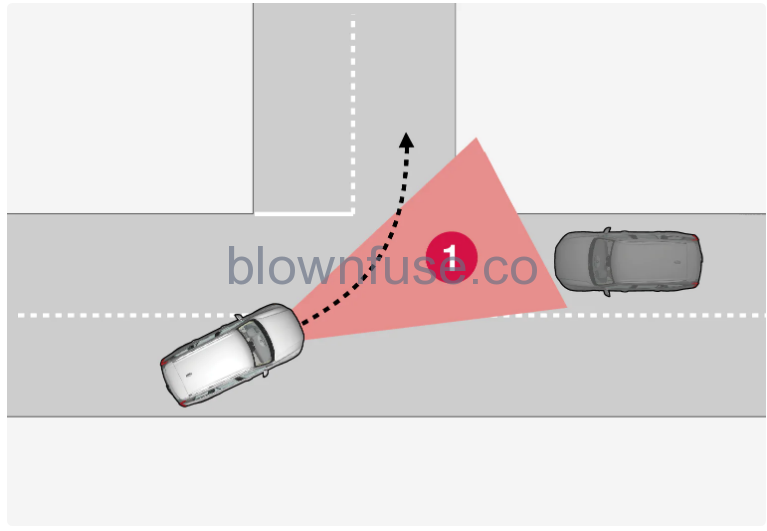
Examples are:
- If there are slippery driving conditions and stability control intervenes.
- If the oncoming vehicle is detected too late.
- If the oncoming vehicle is obscured by something.
- If the oncoming vehicle has headlamps switched off.
- If the oncoming vehicle drives in an unpredictable manner, for example, abruptly changes lanes at a late stage.
This function uses the car’s camera and radar units, which have certain general limitations.
City Safety steering assistance for evasive maneuver
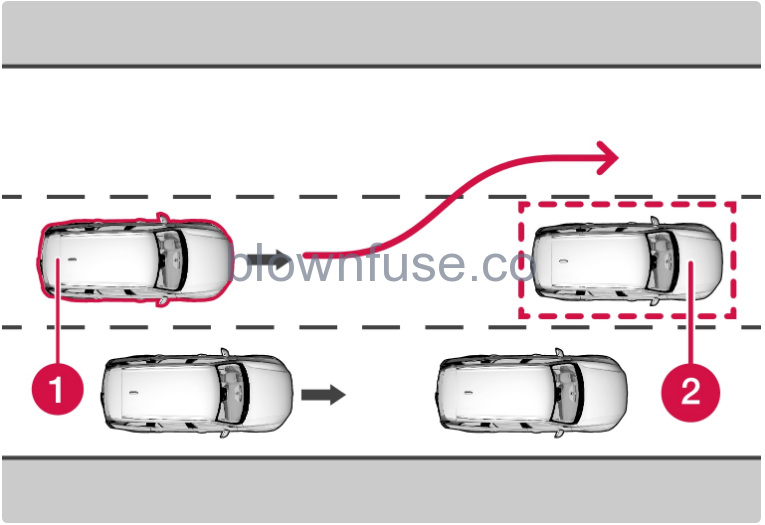 Your car steers away.
Your car steers away.- Slow-moving/stationary vehicles or obstacles.
- City Safety engages by amplifying the driver’s steering input, which only occurs after the driver has begun an evasive maneuver – and then only if the driver is not steering enough to avoid a collision.
- In parallel with the amplified steering input, the brake system is also used to further amplify the steering input. The function also helps to straighten the car again after passing the obstacle.
City Safety steering assistance can detect:
- vehicles
- cyclists
- pedestrians
- larger animals.
Limitations of City Safety steering assistance when taking evasive action
- outside the speed range of 50-100 km/h (30-62 mph)
- if the driver initiates an evasive maneuver
- if the steering servo creating speed-dependent steering wheel resistance is working at reduced power – e.g. when cooling due to overheating.
Note
This function uses the car’s camera and radar units, which have certain general limitations.
Automatic braking in the event of an impeded evasive maneuver with City Safety
City Safety assists the driver by continuously attempting to anticipate whether there are “escape routes” to the side in case a slow or stationary vehicle ahead is discovered at a late stage.
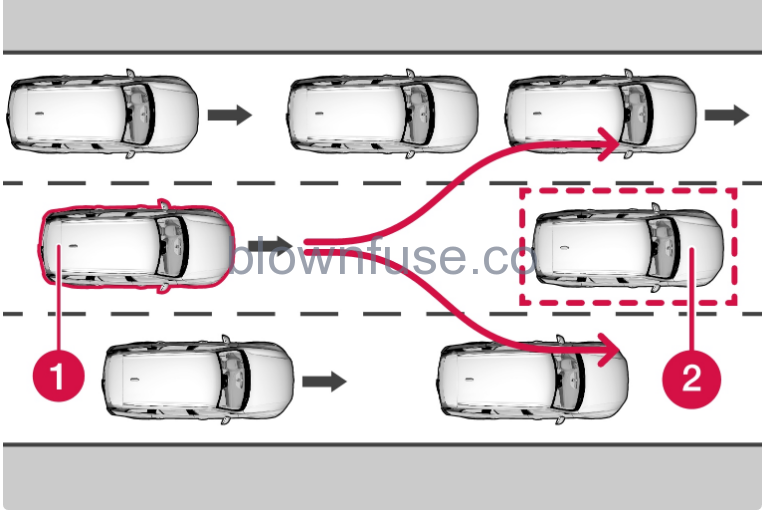 Your car (1) “sees” no options for evading the vehicle ahead (2) and can therefore auto-brake earlier.
Your car (1) “sees” no options for evading the vehicle ahead (2) and can therefore auto-brake earlier.| 1 | Your car |
| 2 | Slow/stationary vehicle |
City Safety does not intervene with the auto-brake function as long as the driver him/herself has the opportunity to avoid a collision via a steering maneuver. However, if City Safety anticipates that an evasive maneuver is not possible due to traffic in an adjacent lane, the function can assist the driver by automatically starting to brake at an earlier stage.
Detection of obstacles with City Safety
Vehicles
City Safety detect most vehicles that are stationary or moving in the same direction as the driver’s own car. This function can also detect oncoming vehicles and cross traffic in certain cases. In order that City Safety shall be able to detect a vehicle in the dark, the vehicle’s front and rear lights must be working and clearly illuminated.
Cyclists
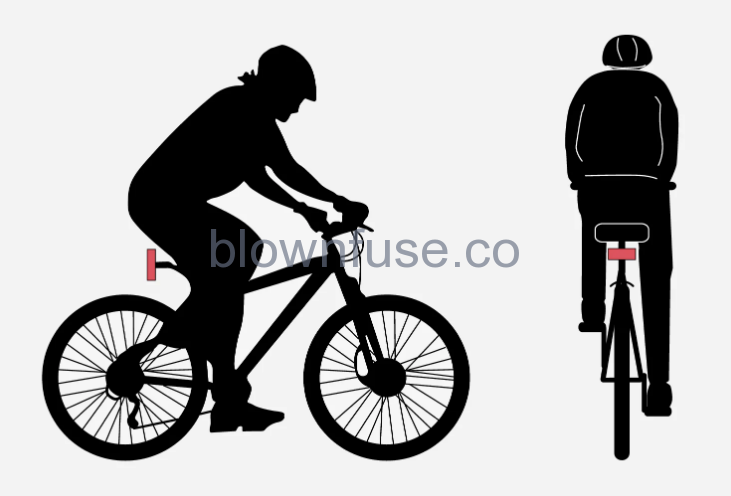 Examples of what City Safety interprets as a cyclist — with clear body outline and bicycle outline.
Examples of what City Safety interprets as a cyclist — with clear body outline and bicycle outline.- Good performance requires that the system function that detects a cyclist must receive the clearest possible information about the body and bicycle outline, requiring the ability to identify the bicycle, head, arms, shoulders, legs, upper and lower body plus a normal human pattern of movement.
- If large parts of the cyclist’s body or bicycle are not visible to the function’s camera then the system cannot detect a cyclist.
- For the function to be able to detect a cyclist, he/she must be an adult and riding a bicycle designed for adults.
City Safety is supplementary driver support, but it cannot detect all cyclists in all situations and, for example, cannot see:
- partially obscured cyclists.
- cyclists if the background contrast for the cyclists is poor.
- cyclists wearing clothing that obscures the body outline.
- bicycles loaded with large objects.
Warnings and brake interventions could be late or not occur at all. The driver is always responsible that the vehicle is driven correctly and with a safety distance adapted to the speed.
Pedestrians
 Examples of what the system regards as pedestrians with clear body outlines.
Examples of what the system regards as pedestrians with clear body outlines.- Good performance requires that the system function that detects a pedestrian must receive the clearest possible information about the body outline, requiring the ability to identify the head, arms, shoulders, legs, upper and lower body plus a normal human pattern of movement.
- In order that it shall be possible to detect a pedestrian there must be a contrast with the background and this will be affected by such things as clothes, the background and the weather. With poor contrast the pedestrian may either be detected late or not at all, which may mean that warnings and braking are late or omitted.
- City Safety can also detect pedestrians in the dark if they are illuminated by the car’s headlamps.
Warning
City Safety is supplementary driver support, but it cannot detect all pedestrians in all situations and, for example, cannot see:
- partially obscured pedestrians, people in clothing that hides their body contour or pedestrians shorter than 80 cm (32 in.).
- pedestrians if the background contrast for the pedestrians is poor.
- pedestrians who are carrying larger objects.
Warnings and brake interventions could be late or not occur at all. The driver is always responsible that the vehicle is driven correctly and with a safety distance adapted to the speed.
Large animals
 Examples of what City Safety interprets as large animals – standing still or walking slowly and with clear body outline.
Examples of what City Safety interprets as large animals – standing still or walking slowly and with clear body outline.- Good performance requires that the system function that detects a large animal (e.g. elk and horse) must receive the clearest possible information about the body outline, requiring the ability to identify the animal directly from the side in combination with what is a normal pattern of movement for the animal.
- If parts of the animal’s body are not visible to the function’s camera then the system cannot detect the animal.
- City Safety can also detect large animals in the dark if they are illuminated by the car’s headlamps.
Warning
City Safety is supplementary driver support, but it cannot detect all large animals in all situations and, for example, cannot see:
- partially obscured large animals.
- larger animals seen from the front or from behind.
- large animals that run or move quickly.
- large animals if the background contrast for the animals is poor.
- small animals such as dogs and cats, for example.
- Warnings and brake interventions could be late or not occur at all. The driver is always responsible that the vehicle is driven correctly and with a safety distance adapted to the speed.
